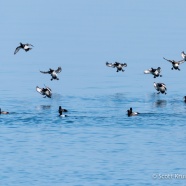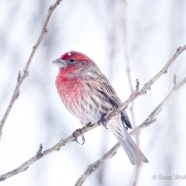Scaup Surge
Thanks to recent warm temperatures and favorable winds, Greater Scaup (Aythya marila) like those shown here are now on the move back to the north, and during the past couple of weeks their numbers have been growing across the region. While you can find some throughout the winter in open areas on large bodies of water such as Lake Erie, most members of this species migrate south to evade the cold. We have been able to enjoy several thousand – probably 5,000 or 6,000 and maybe more – in the waters of Long Island Sound off Stratford Point. Most stay rather far offshore and away from...
Read MoreFrost Free Frogs?
“The animal kingdom relies on staggering evolutionary innovations to survive winter.” Bernd Heinrich renowned biologist and author – made this statement in his bestselling book entitled “Winter World”. The Wood Frog (Rana sylvatica) is a true embodiment of this statement; these tiny amphibians can survive for weeks with an incredible two-thirds of their body water completely frozen—to the point where they are essentially solid frogsicles! The adaptation that enables this remarkable feat is known as a cryoprotectant – a substance that prevents damage to cells and tissues during...
Read MoreMale House Finch
Here is a recent photo of a male House Finch (Haemorhous mexicanus) on a snowy afternoon. The beautiful red shades of this guy really stand out against the drab surroundings, and their cheery songs can already be heard here in February on some of the warmer, sunnier days. It is one of the first signs of “spring” as the days began to grow longer. The Purple Finch (Haemorhous purpureus) is a similar species and often confused with the House Finch, especially because both enjoy coming to backyard bird feeders. Roger Tory Peterson described the Purple Finch as having been...
Read MoreDark-eyed Junco
The Dark-eyed Junco (Junco hyemalis) is one of our most familiar backyard feeder birds. They are a species we can find year-round as they nest in some of our woodlands in western New York. They used to be known as the “snowbird” likely because of their abundance in pouring down from the north into all of the continental United States during the winter. Their plumage, grays and browns above with white below, also seem to fit so perfectly on a snowy landscape. This bird was photographed during a recent snowstorm looking regal as can be while living up to its name. Have you ever...
Read MoreGreen-breasted Mango (Anthracothorax prevostii) Female Feathers
We showed you RTPI Affiliate Sean Graesser’s look at the feathers of a male Green-breasted Mango (Anthracothorax prevostii) hummingbird, and now here is the female. Exquisite! Much more to come from Costa Rica…
Read More








